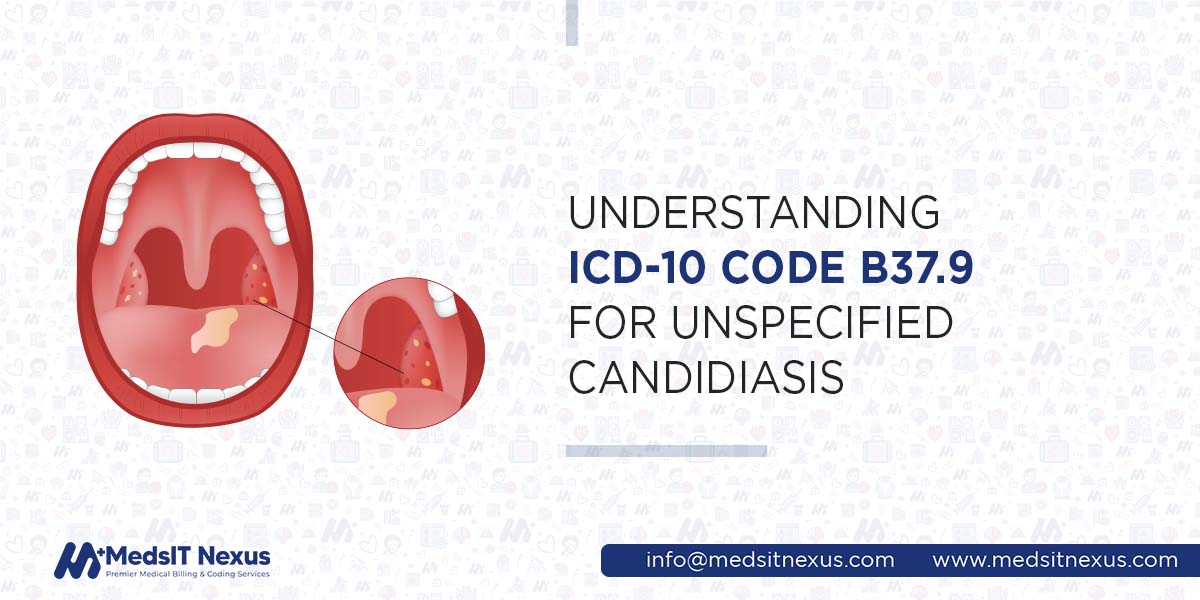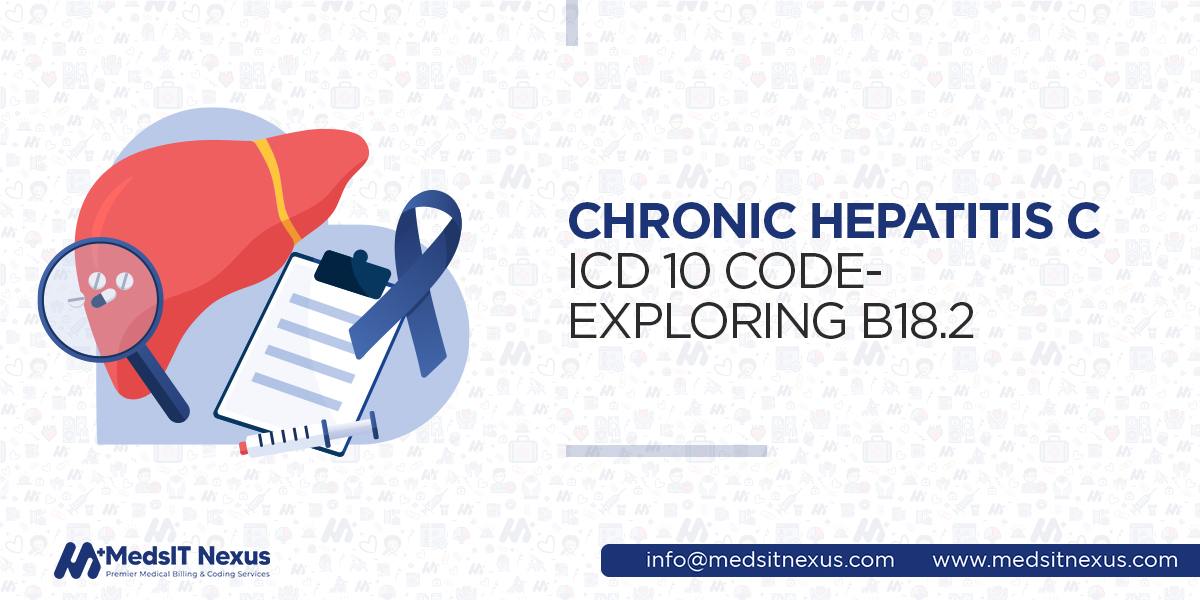Understanding ICD-10 Code B37.9 for Unspecified Candidiasis

Understanding ICD-10 code B37.9 is crucial for healthcare professionals when dealing with
unspecified candidiasis cases, ensuring accurate documentation and billing. ICD-10 Code B37.9, for
Unspecified Candidiasis, presents a unique challenge within the healthcare industry, given its variable
manifestations and the necessity for precise documentation. MedsIT Nexus Medical Coding Services stands
at the forefront of healthcare excellence, and our commitment to precision and professionalism shines
brightly in our expertise regarding the ICD-10 Code B37.9 for Unspecified Candidiasis.
For people seeking information on ICD-10 code B37.9, this post is a complete guideline for understanding
unspecified candidiasis coding.
ICD-10-CM Code for Candidiasis, unspecified B37.9
B37.9 serves as a billable ICD-10 code within the medical classification, specifically designed to
denote the "candidiasis, unspecified." Unspecified diagnosis codes, such as B37.9, are crucial in the
medical coding system. They become necessary when clinical information regarding a particular medical
condition remains unknown or is unavailable.
This code holds validity within the fiscal year 2023, encompassing the time frame from October 01, 2022,
to September 30, 2023, to submit HIPAA-covered transactions within the healthcare industry. ICD-10 Code
B37.9 is a crucial tool for healthcare professionals, facilitating precise diagnosis and treatment.
Version: ICD-10-CM 2023
Abbreviated form: Candidiasis, unspecified
Complete form: Candidiasis, unspecified
Code History: Code History: The ICD-10-CM code B37.9 has maintained a consistent status
in its coding history, demonstrating stability and continuity in its usage over the years. Since its
introduction in 2016, the first year of its non-draft implementation, this code has seen no alterations
or revisions in subsequent years up to its latest effective date in 2023.
Includes: Thrush NOS
Validity: Valid for submission of the claim, reimbursable
Why Unspecified?
Sometimes, medical records may not specify the type or location of Candidiasis. This lack of specificity
could be due to various reasons, including incomplete documentation or a preliminary diagnosis pending
further evaluation.
While the medical community generally favors using more specific diagnostic codes to enhance precision,
there are instances where the clinical information is insufficient to pinpoint a more precise diagnosis.
In such cases, employing unspecified codes, like B37.9, is not only permissible but also medically
justifiable, as they accurately reflect the limited information available about a patient's condition.
Coding structure
Chapter (A00-B99) - Certain infectious and parasitic diseases
Section (B35-B49) - Mycoses
Subsection (B37) - Candidiasis
Specific Code (B37.9) - Candidiasis, unspecified
In medical coding, the "B" denotes infections and parasitic diseases, with "37" designating Candidiasis.
The ".9" at the end signifies an unspecified type within this category.
Clinical information
Candidiasis is a fungal infection due to Candida species, with Candida "Albicans” being the most common
culprit.
Unspecified Candidiasis can manifest in several ways, including:
Oral Thrush: This common form of Candidiasis affects the mouth and throat. It is often
seen as white, cottage cheese-like patches on the tongue and inner cheeks. Oral Candidiasis can be
chronic hyperplastic Candidiasis, erythematous, and pseudomembranous.
Vaginal Candidiasis: The disease is commonly called a yeast infection and affects
women. It results in itching, burning, and abnormal cottage cheese-like vaginal discharge.
Cutaneous Candidiasis: This involves skin infections, which can lead to red, itchy
rashes and, sometimes, pustules
Systemic Candidiasis: In severe cases, Candida can enter the bloodstream, leading to
systemic infections. This is a severe condition with symptoms like fever, chills, and organ dysfunction.
Invasive Candidiasis: A severe form that can affect internal organs, typically
occurring in individuals with weakened immune systems.
Symptoms
Symptoms may range from mild discomfort to extreme infections depending on the location and extent of the infection. Common symptoms include itching, redness, swelling, and, in oral candidiasis cases, white patches in the mouth.
Risk Factors
Individuals with weakened immune systems, such as HIV or Acquired Immunodeficiency Syndrome, cancer patients undergoing chemotherapy, and organ transplant recipients, are more susceptible to Candidiasis. Moreover, prolonged use of antibiotics, corticosteroids, or immunosuppressive drugs can also increase the risk.
Prevention
- Practice good hygiene.
- Maintain a balanced diet.
- Avoid unnecessary use of antibiotics.
- Use antifungal medication as prescribed.
- In some cases, antifungal prophylaxis might be necessary for high-risk individuals.
Diagnostic Related Groups - MS-DRG Mapping
ICD-10-CM code B37.9 is categorized under several specific Diagnostic Related Groups (DRGs) as outlined
in version 40.0 of the Medicare Severity-Diagnosis Related Group (MS-DRG) system.
MS-DRG 867: It involves "Other infectious and parasitic diseases diagnoses with Major
Complications or Comorbidities (MCC)" with a relative weight of 2.1134.
MS-DRG 868: It involves "Other infectious and parasitic diseases diagnoses with
Complications or Comorbidities (CC)."
with a relative weight of 1.0557
MS-DRG 869: "Other Infectious and Parasitic Diseases Diagnoses without Complications or
Comorbidities (CC/MCC)" with relative weight 0.7408
MS-DRG 974: "HIV with Major Related Condition with MCC"
MS-DRG 975: It involves "HIV with major related condition with CC."
MS-DRG 976: "HIV with the major related condition without CC/MCC."
Related Codes Browser
B37.0 (Candidal stomatitis)
Candidal stomatitis is an infection of the mouth and throat caused by Candida. It often presents as
white patches on the tongue and inner cheeks, accompanied by discomfort and pain.
B37.1 (Pulmonary candidiasis)
Pulmonary Candidiasis refers to Candida infection in the lungs. This condition is commonly seen in
individuals with compromised immune systems.
B37.2 (Candidiasis of skin and nail)
Cutaneous Candidiasis affects the skin, resulting in itching, redness, and rashes. It typically occurs
in warm, moist body areas like the groin or armpits.
B37.3 (Candidiasis of vulva and vagina)
This condition primarily affects females and involves Candida infection in the genital area, leading to
symptoms like itching, burning, and discharge.
B37.31 (Acute candidiasis of vulva and vagina)
Vulvovaginal Candidiasis is prevalent among women and is characterized by itching, burning, and vaginal
discharge. The acute form, represented by B37.31, indicates a sudden onset and short-term presentation
of Candidiasis in the vulva and vagina.
B37.32 (Chronic candidiasis of vulva and vagina)
Chronic vulvovaginal Candidiasis, coded as B37.32, refers to a recurrent or persistent form of
Candidiasis in the vulvar and vaginal areas. It manifests with similar symptoms as the acute variant but
recurs over an extended period, necessitating specialized treatment and management.
B37.4: (Candidiasis of other urogenital sites)
Candidiasis can also impact other urogenital sites apart from the vulva and vagina. It includes
infections in the urinary tract and other reproductive organs.
B37.41 (Candidal cystitis and urethritis)
This code is used when Candida infects the urinary tract, causing symptoms like painful urination,
frequent urination, and lower abdominal pain. It can affect both men and women and often occurs in
individuals with compromised immune systems.
B37.42 (Candidal balanitis)
Candidal balanitis refers explicitly to a Candida infection of the male genital area, affecting the head
of the penis. It can cause redness, itching, and discomfort.
B37.49 (Other urogenital candidiasis)
Sometimes, Candida infections can affect various parts of the urogenital tract, including the vagina,
vulva, and cervix in women. In men, it can impact the prostate gland or seminal vesicles. This code
encompasses all urogenital Candida infections not classified under the previous codes.
B37.5 (Candidal meningitis)
Candidal meningitis is a rare but serious infection of the membranes of the brain & spinal cord and is
often seen in individuals with weakened immune systems.
B37.6 (Candidal endocarditis)
Candidal endocarditis involves the infection of the heart's inner lining and valves. It can lead to
heart murmurs, fever, and other cardiac complications.
B37.7 (Candidal sepsis)
Candidal sepsis refers to a bloodstream infection with Candida. This can occur in individuals with
severe underlying health conditions and can be life-threatening.
B37.8 (Candidiasis of other sites)
This code covers Candidiasis affecting other body parts, including the gastrointestinal tract, urinary
tract, and skin.
B37.81 (Candidal esophagitis)
This code is used when Candida infection affects the esophagus, causing symptoms like difficulty
swallowing.
B37.82 (Candidal enteritis)
Candidal enteritis is a relatively rare but severe condition where Candida infects the gastrointestinal
tract. It can lead to symptoms such as abdominal pain, diarrhea, and fever.
B37.83 (Candidal cheilitis)
Candidal cheilitis is a specific form of Candidiasis affecting the lips. It presents with redness,
scaling, and fissures at the corners of the mouth.
B37.84 (Candidal otitis externa)
Candidal otitis externa refers to a fungal infection of the outer ear canal. Symptoms may include
itching, pain, and discharge.
B37.89 (Other sites of candidiasis)
B37.89 code encompasses Candidiasis occurring in sites other than those specified by other codes. It
includes infections of the esophagus, respiratory tract, and even nail beds.
Unlock Precision and Excellence with MedsIT Nexus: Your Trusted Partner for ICD-10 Code B37.9
MedsIT Nexus, we are proud to announce our unparalleled mastery in this field. Our expert team
specializes in ICD-10 coding, and we excel at handling complex cases like B37.9, Unspecified
Candidiasis. Trust us to ensure precise DRG assignment, guaranteeing optimal reimbursement for your
healthcare facility. With a track record of excellence, cutting-edge technology, and a commitment to
compliance, MedsIT Nexus is your strategic partner in achieving coding precision and
financial success.
Join us in elevating your medical coding to the highest standards of excellence.
Moreover, our expertise extends beyond just coding proficiency. The correct DRG assignment is pivotal
for healthcare facilities to optimize reimbursement and streamline resource allocation. MedsIT
Nexus
Medical Coding Services also excel in this arena, as we possess an unrivaled knowledge of
the DRG
classification system, ensuring that healthcare providers are compliant and financially efficient.
Dr. Sana Pervez, Pharm.D, CCS, CPC -
Clinical Compliance Advisor at MedsIT Nexus
Responsible for Medical and compliance review of all healthcare RCM and billing content before publication.






